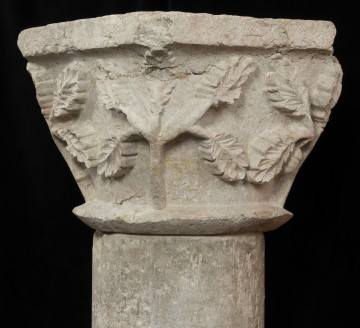
Capitol with representation of four apostles
1330 — 1340
National Museum in Szczecin
Part of the collection: Romanesque and early gothic stone capitals
The capital, with sides decorated with bas-relief images of the apostles, together with the capital presenting the scene of the monks’ meal, was found in the ruins of the Szadzko Castle. It is assumed that it originally formed an architectural decoration of the interior of the Cistercian monastery in Kołbacz. The analogous shape, typical for Romanesque columns, and the mode of sculpting with the use of similar formal and stylistic motives prove that it was made by stonemasons working in one workshop. The workshop preparing the commission of the Kołbacz Cistercian monks was from Gotland, an island which used to be the commercial centre and a thriving Baltic hub in the Middle Ages. In the first half of the 14th century, numerous stonemason workshops operated there. Among works showing close analogies to the Pomeranian capitals, there are the sculptural decorations of church porches in Gammelgarn, Martebo, Dalhem and Stanga, related to the works of the masters from Martebo, Fabulator and Egipticus. They include the typical images of St. Peter holding a large key, St. Paul with a symmetrically arranged and decoratively wavy hairdo, or the characteristic motive of decorating the brims of clothing with the use of a double engraved line.
Kinga Krasnodębska
Author / creator
Dimensions
cały obiekt: height: 37 cm, width: 45 cm
Object type
capital (architecture)
Creation time / dating
Creation / finding place
Identification number
Location / status

1330 — 1340
National Museum in Szczecin

1330 — 1340
National Museum in Szczecin

1330 — 1340
National Museum in Szczecin
DISCOVER this TOPIC
National Museum in Lublin
DISCOVER this PATH
Educational path